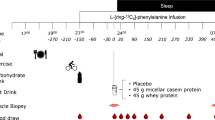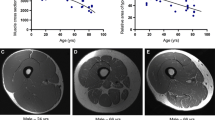Abstract
The total metabolic energy expenditure associated with active Na−K-transport over the first 20 min of stimulation with insulin, adrenaline or salbutamol (ΔHmNa−K) was determined from direct calorimetric and tracer ion flux measurements in isolated muscles at rest. The reversible work performed by the Na−K-pump during the same interval of time (WrevNa−K) was calculated as the product of the ouabain-suppressible Na−K transfers and the mean free energy increase imparted to the two ions as they are transported against their electrochemical gradients across the plasma membrane. Comparison of membrane potential and intracellular Na and K concentrations before and after the stimulations indicated that part of WrevNa−K had contributed to increase the ion electrochemical gradients in the preparation (i.e. had not been lost as heat) during the 20 min period. Accordingly, the maximum value of ΔHmNa−K was taken as the sum of the ouabain-suppressible heat production and WrevNa−K. Following stimulation with insulin, adrenaline or salbutamol this maximum corresponded to 10, 10 and 12% respectively, of basal metabolism. Under the same three conditions, the minimum “energetic efficiency” of the active Na−K-transport process, defined as the ratio between WrevNa−K and maximum ΔHmNa−K, was 35, 41 and 38%, respectively.
Similar content being viewed by others
References
Beitner R, Kalant N (1971) Stimulation of glycolysis by insulin. J Biol Chem 246:500–503
Biron R, Burger A, Chinet A, Clausen T, Dubois-Ferrière R (1979) Thyroid hormones and the energetics of active sodiumpotassium transport in mammalian skeletal muscles. J Physiol 297:47–60
Chinet AE (1981) Balance of respiration-derived energy in perifused preparations. J Physiol 318:58P
Chinet A, Clausen T, Girardier L (1977) Microcalorimetric determination of energy expenditure due to active sodium-potassium transport in the soleus muscle and brown adipose tissue of the rat. J Physiol 265:43–61
Clausen T, Flatman JA (1977) The effect of catecholamines on Na−K transport and membrane potential in rat soleus muscle. J Physiol 270:383–414
Clausen T, Flatman JA (1980) 166-1 mediate the stimulating effect of adrenaline on active electrogenic Na−K-transport in rat soleus muscle. Br J Pharmacol 68:749–755
Clausen T, Kohn PG (1977) The effect of insulin on the transport of sodium and potassium in rat soleus muscle. J Physiol 265:19–42
Clausen T, Martin BR (1977) The effect of insulin on the washout of (45Ca) calcium from adipocytes and soleus muscle of the rat. Biochem J 164:251–255
Creese R, Scholes NW, Whalen WJ (1958) Resting potentials of diaphragm muscle after prolonged anoxia. J Physiol 140:301–317
Dengler R, Hofman WW, Rudel R (1979) Effects of potassium depletion and insulin on resting and stimulated skeletal rat muscle. J Neurol Neurosurg Psychiatr 42:818–826
Denton RM, McCormack JG (1980) On the role of the calcium transport cycle in heart and other mammalian mitochondria. FEBS Lett 119:1–8
Dubois-Ferrière R, Chinet AE (1981) Contribution of skeletal muscle to the regulatory non-shivering thermogenesis in small mammals. Pflügers Arch 390:224–229
Flattman JA, Clausen T (1979) Combined effects of adrenaline and insulin on active electrogenic Na+−K+-transport in rat soleus muscle. Nature 281:580–581
Gilbert JR, Meissner G (1982) Sodium-calcium ion exchange in skeletal muscle sarcolemmal vesicles. J Membr Biol 69:77–84
Horwitz BA, Eaton M (1977) Ouabain-sensitive liver and diaphragm respiration on cold-acclimated hamster. J Appl Physiol: Respiral Environ Exercise Physiol 42:150–153
Ismail-Beigi F, Edelman IS (1970) Mechanism of thyroid calorigenesis: role of active sodium transport. Proc Natl Acad Sci USA 67:1071–1078
Keynes RD, Maisel GW (1954) The energy requirement for sodium extrusion from a frog muscle. Proc R Soc B 142:382–392
Kohn PG, Clausen T (1971) The relationship between the transport of glucose and cations across cell membranes in isolated tissues. VI. The effect of insulin ouabain and metabolic inhibitors on the transport of 3-O-methyl-glucose and glucose in rat soleus muscles. Biochim Biophys Acta 225:227–290
Morowitz HJ, (1978) Foundations of bioenergetics, chapter 14. Academic Press, New York San Francisco London, p 197
Rasmussen M-JK, Clausen T (1982) The stimulating effect of 3′,5′-cyclic adenosine monophosphate and lipolytic hormones on a 3-O-methylglucose transport and45Ca-release in adipose tissue and skeletal muscle of the rat. Biochim Biophys Acta 693:389–397
Author information
Authors and Affiliations
Rights and permissions
About this article
Cite this article
Chinet, A., Clausen, T. Energetics of active sodium-potassium transport following stimulation with insulin, adrenaline or salbutamol in rat soleus muscle. Pflugers Arch. 401, 160–166 (1984). https://doi.org/10.1007/BF00583876
Received:
Accepted:
Issue Date:
DOI: https://doi.org/10.1007/BF00583876




